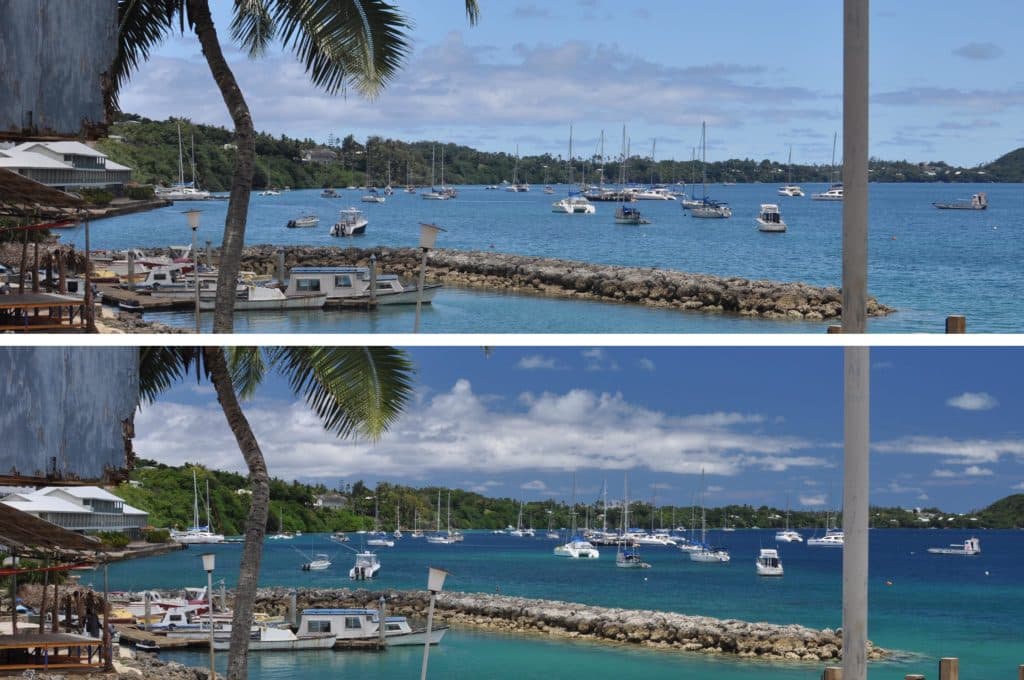
We were in Bora Bora, French Polynesia, motoring inside the reef, when I noticed the turquoise water reflected on the underside of a nearby cloud. I grabbed my camera to record the phenomena. No matter how I fussed with my camera’s settings, I couldn’t capture what I was seeing. Then I realized I was seeing this through my polarized sunglasses. I lifted them up and it disappeared. I decided right then to buy a polarizing filter (commonly called a polarizer) for my camera lens. It’s one of the best photography decisions I’ve made.
When sunlight hits water, foliage, glass, and other nonmetallic reflective surfaces, the scattered, reflected light makes colors appear desaturated, the water and glass flat, and scenes comparatively hazy or washed out. This effect is more pronounced when the sun is at specific angles. A polarizer restricts the light that reaches a camera lens to that which is perpendicular to reflected light. The effect is the same as with a pair of polarized sunglasses: darker sky (making clouds appear sharper and more distinct), richer colors, and water and glass rendered transparent. In short, outdoor photos taken with a polarizer are often crisper, more vibrant and more dramatic than those without.
We’re cruising through landscapes I might never visit again. I enjoy preserving these memories with a camera, but I’m just an amateur. Capturing them as beautifully as I’m seeing them is so easy with a polarizer, it feels like cheating. Ready to see a marked improvement in your own outdoor photos? Following are some tips for selecting and using a polarizing filter.
- Like most filters and add-ons, polarizers are intended for cameras with removable lenses. Most point-and-shoot cameras and smartphone cameras are not compatible with external filters.
- There are two types of polarizing filters: linear and circular. Nearly all autofocus/auto-exposure cameras require circular polarizers.
- Camera-lens threads are standard, even on Nikons and Canons, so you need pay attention to only the diameter of your lens and buy the same-diameter filter (such as 52mm, 58mm, and 77mm).
- You get what you pay for. Inexpensive polarizers are built with aluminum rings, and these can bind with the threads of the lens. Also, better polarizers are multicoated, which prevents ghosting, lessens lens flare, and preserves contrast.
- Standard polarizing filters can introduce a slight blue hue to photos. Nautical photographer Billy Black (who has shot countless covers and spreads for Cruising World) says he prefers the warming type of polarizing filter because it removes a bit of the blue-green tones from images, giving his photos a more pleasant color balance.
- Reflections are not inherently bad. A circular polarizer allows you to select the amount of polarized light you wish to filter out, from none to all.
- Like polarized sunglasses, a polarizing filter reduces the amount of light that reaches your lens. In most cases, a camera will adjust the exposure to compensate. In other cases, the reduced light is not desirable.
- Once you begin using a polarizer, you’ll be surprised by the reflections you didn’t realize were there until they are gone. Even car tires are muted by reflected light and utterly changed when viewed through a polarizing filter.
- While post-processing software can do amazing things to a digital image, none can reproduce the effect of a polarizing filter.
Check out more tips on cruising photography here.








